Picture book differences between the main bookshop chains in the US and UK - Paeony Lewis
Last month I was in the USA and naturally I looked at picture books in shops. How could I not?! This included Barnes & Noble bookstores in three states. As a major chain I assumed Barnes & Noble in the US would be very similar to Waterstones in the UK. Yes and no. I began to notice there were some differences between the US and UK picture-book sections and I thought I'd share my unscientific observations. Of course I haven't forgotten there are lots of brilliant independent bookstores in both countries but they don't have to follow standardised directives from Head Office and so they're more individual and can't be compared in the same way.
 Barnes & Noble in the US
Barnes & Noble in the US
The main picture book section was made up of hardbacks.
Selected books are front facing and the rest are spine outwards.
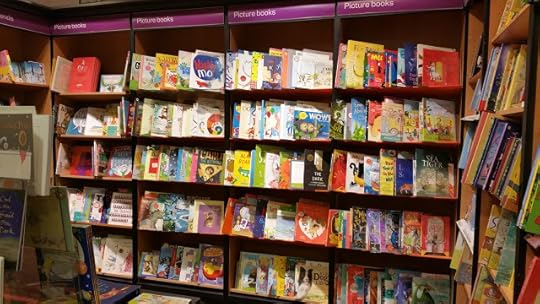 Waterstones in the UK
Waterstones in the UK
Most picture books are paperbacks and they're displayed sideways
because the spine of a paperback is insignificant.
To me the biggest difference was the dominance of hardback picture books (with jackets) in Barnes & Noble. I’d love a knowledgeable person to explain to me why there's such an emphasis on hardbacks in the US. I’m truly baffled and appreciate there must be a reason. Perhaps it's because hardbacks have shelf presence and you can easily read the spine. They’re substantial and feel gorgeous, especially with decorative endpapers. Unfortunately though, US picture book hardbacks are typically $17.99 (c£12) which is expensive for an everyday item. So are they mainly purchased as gifts? Does this mean Americans buy fewer picture books or do they simply spend more? A British paperback picture book is typically £6.99 (c$10), and special offers often lower this further. So per family, do we buy more picture books in the UK? I've no idea, although I'm told the US doesn't have the equivalent of Book Start.
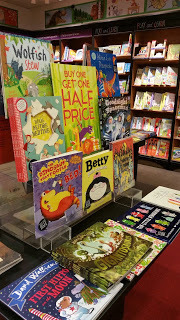 Waterstones UK
Waterstones UK
Paperback discounts: '3 for 2'
and 'Buy 1 get 1 half price'
are always popular.
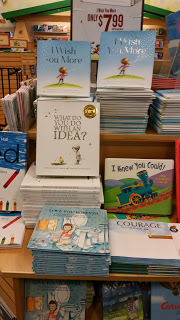 Barnes & Noble US
Barnes & Noble US
A rare price reduction.
Both US and UK have
loyalty schemes.With the majority of picture books in Barnes & Noble being pricey hardbacks, I wonder if this discourages the adult from allowing the child to pick a book that might not appeal to the parent? Also, I noticed many of the hardbacks seemed aimed at older children and perhaps this is a sign that in the US picture books aren’t cast aside (by adults – never children) when the child reaches five years. I wish the reading of picture books by older children was encouraged more in the UK. I don't think many British parents realise how sophisticated picture books can be and how they promote discussion.
Despite the plethora of love books, funny books and moral themes in Barnes & Noble, I noticed a ‘grumpiness’ theme too. That surprised me. I remember submitting a ‘grumpy’ book in the UK a few years ago and received feedback that the grumpy adult hippo was too irresponsible in terms of caring for the little hippo. Perhaps I was unknowingly following a grumpy, humorous American zeitgeist! In fact, more than in the UK, I thought quite a few US books seemed to push way beyond the boundaries of cute and cuddly, with exaggerated humour that often poked fun at poor parenting (more so than in the UK). Plus the style of many illustrations wasn't quite the same as in the UK (often more cartoony in an adult way - though it's hard to put my finger on it).
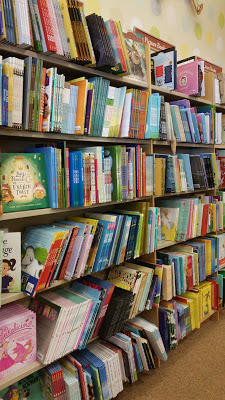 B&N US
B&N US
More picture book shelves from another B&N.
Lots of hardback picture books squeezed onto the shelves and the hardback spines allow for identification.
With only a spine I assume the title must be even more important. To me the lack of front-facing books
doesn't seem to encourage browsing, but they can squeeze more books on the shelves.
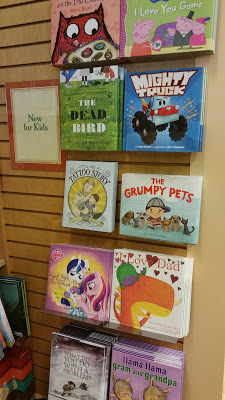 B&N US
B&N US
It's much easier to make a choice when the covers can be seen.
Visibility is a perennial problem for picture books.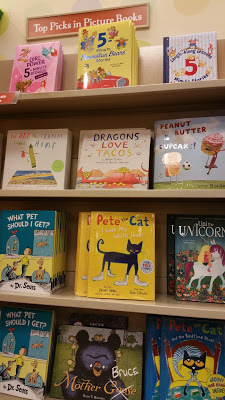 B&N US
B&N US
Rhyming picture books used to be much more popular with publishers in the US than UK. I suspect that was because the US internal market is huge and they didn’t worry about overseas co-editions and translations as much as UK publishers. So in the US there has always been a high number of rhyming picture books and Dr Seuss continues to remain far more prominent than in the UK. Meanwhile in the UK, rhyme is still growing on the back of the phenomenal success of Julia Donaldson. Nowadays every Waterstones in the UK appears to have a large section devoted to Julia Donaldson's rhyming picture books, but I didn’t see this in Barnes & Noble in the US and only noticed one of her books: The Gruffalo. Instead, the author with the most shelf space in the US Barnes & Nobles appeared to be Mo Williems. We enjoy his Pigeon books in the UK (eg Don't Let the Pigeon Drive the Bus), though his other humorous books haven’t taken off in the UK in the same way as in the US.
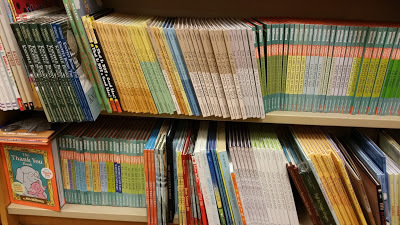 B&N US The author with the most shelf space was Mo Williems.
B&N US The author with the most shelf space was Mo Williems.
More than two thirds of the books in this photo are by this author/illustrator.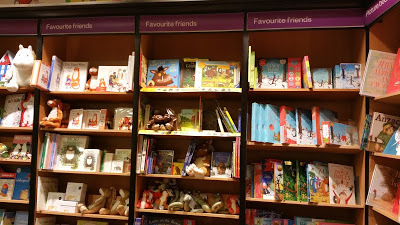 Waterstones UK I suspect you can guess the author with the most shelf space in the UK!
Waterstones UK I suspect you can guess the author with the most shelf space in the UK!
Two thirds of this photo is linked to Julia Donaldson (books and merchandise).
Now it’s time for my greatest befuddlement. Why do almost all the American hardbacks in Barnes & Noble have flimsy, tearable, non-child-friendly jackets? Am I the only one who thinks this is madness?! I know some UK publishers add jackets to hardbacks too, but not to the same extent. And now I’ve thought about it, the lovely hardback versions of my No More Yawning and No More Biscuits didn’t have jackets in the UK, but they did in the US.
I wonder what happens to these jackets? Do American parents remove the jackets when they get them home? Or are the jacketed hardbacks kept on a special shelf in case they’re damaged? Are additional jackets still run off the printing press so booksellers have extras (which need to be stored). It’s beyond me – please will somebody explain!!
I’ll stop ranting and move on to something I liked: the Little Books for Little Hands section in Barnes & Noble that's aimed at 0-3 years. The title of the section says it all. They’re robust board books of classic, truncated and new stories and are strongly constructed for children to handle (chew, stomp, pull, share...). I thought this section was larger than the board book section you’ll find in a UK Waterstones. Perhaps it's to make up for the plethora of pricey US hardbacks?
 B&N US: 'Little Books for Little Hands' 0-3 years
B&N US: 'Little Books for Little Hands' 0-3 years
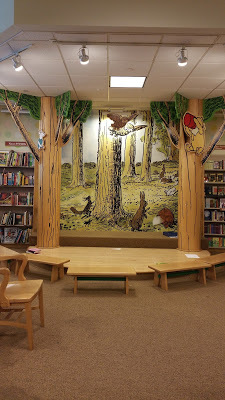 The B&N stores in three different states all included
The B&N stores in three different states all included
the same stage in the children's section.
A lovely idea for events to bring in customers, though perhaps US stores have more space than Waterstones in the UK? I wasn't so wild about all the toys sold in Barnes & Noble stores and they're far more appealing to young children's than rows of hardbacks with just the spines on show.
I wasn't so wild about all the toys sold in Barnes & Noble stores and they're far more appealing to young children's than rows of hardbacks with just the spines on show.
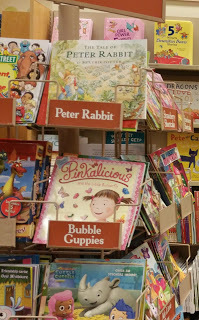
Also new to me at Barnes & Noble were the small, cheap paperback versions of picture books (smaller than typical paperback picture books in the UK). Proportionately there weren't many of these and they were displayed on one or two revolving stands with covers facing outwards.The selection isn’t large and seems to be aimed more at young children reading for themselves. Series and classic bestseller books appear to predominate and my latest US version of I’ll Always Love You is the right size to fit into these stands (ie squarer and smaller than normal picture books).
Whatever my comments, I enjoyed perusing the bookshops in the US and I apologise for not buying many picture books but my suitcase was already stuffed (it didn't help that I was a nut case who brought a full-size pillow along on my travels!). Even so, I couldn’t leave empty handed and squeezed in four books. Only one of those four books may be found on the shelves of Waterstones in the UK (Goodnight Moon), though most could be ordered.
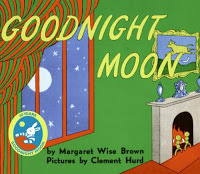 At an independent US bookstore I bought a paperback of the 1947 American classic, Goodnight Moon by Margaret Wise Brown, illus by Clement Hurd (interestingly, the small independent store in North Carolina had a few more of the paperbacks we’re used to in the UK). Published by Harper Trophy
At an independent US bookstore I bought a paperback of the 1947 American classic, Goodnight Moon by Margaret Wise Brown, illus by Clement Hurd (interestingly, the small independent store in North Carolina had a few more of the paperbacks we’re used to in the UK). Published by Harper Trophy
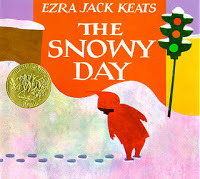 Whilst at the Library of Congress in Washington DC I spotted a paperback of the classic The Snowy Day by Ezra Jack Keats. This book was new to me and in 1962 it was a ground-breaking US picture book in that it portrayed a realistic, multicultural urban setting. Published by Puffin Books
Whilst at the Library of Congress in Washington DC I spotted a paperback of the classic The Snowy Day by Ezra Jack Keats. This book was new to me and in 1962 it was a ground-breaking US picture book in that it portrayed a realistic, multicultural urban setting. Published by Puffin Books
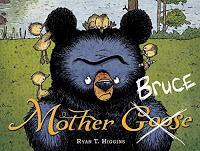 I couldn't resist this hardback from Barnes & Noble. Mother Bruce by Ryan T Higgins really made me giggle. It's about responsibility and so utterly grumpy and naughty! Published by Disney Hyperion in 2015
I couldn't resist this hardback from Barnes & Noble. Mother Bruce by Ryan T Higgins really made me giggle. It's about responsibility and so utterly grumpy and naughty! Published by Disney Hyperion in 2015
 Another hardback from Barnes & Noble. When Spring Comes by Kevin Henkes, illus by Laura Dronzek. I bought this purely for the gorgeous bold illustrations. Published by Greenwillow in 2016I’m somebody who’ll always buy books, whether they’re US hardbacks or cheaper UK paperbacks. Unfortunately this isn’t true of everybody which is why I’m not sure it helps if the newest and most diverse books can only be found in an expensive hardback format in Barnes & Noble bookstores in the US. Would Barnes & Noble make more money if they sold more paperbacks and displayed them cover outwards as is done in Waterstones? Or is the main profit in hardbacks? Regardless, I suspect we'll all agree it should be a priority to get more children reading more picture books, and for adults to enjoy spending time sharing the books.
Another hardback from Barnes & Noble. When Spring Comes by Kevin Henkes, illus by Laura Dronzek. I bought this purely for the gorgeous bold illustrations. Published by Greenwillow in 2016I’m somebody who’ll always buy books, whether they’re US hardbacks or cheaper UK paperbacks. Unfortunately this isn’t true of everybody which is why I’m not sure it helps if the newest and most diverse books can only be found in an expensive hardback format in Barnes & Noble bookstores in the US. Would Barnes & Noble make more money if they sold more paperbacks and displayed them cover outwards as is done in Waterstones? Or is the main profit in hardbacks? Regardless, I suspect we'll all agree it should be a priority to get more children reading more picture books, and for adults to enjoy spending time sharing the books.
By the way, if anybody would like to put me right on the differences I've noticed between the UK and US, it'll be lovely to read your comments. Thanks.
 Paeony Lewis
Paeony Lewis
www.paeonylewis.com
 Barnes & Noble in the US
Barnes & Noble in the USThe main picture book section was made up of hardbacks.
Selected books are front facing and the rest are spine outwards.
 Waterstones in the UK
Waterstones in the UKMost picture books are paperbacks and they're displayed sideways
because the spine of a paperback is insignificant.
To me the biggest difference was the dominance of hardback picture books (with jackets) in Barnes & Noble. I’d love a knowledgeable person to explain to me why there's such an emphasis on hardbacks in the US. I’m truly baffled and appreciate there must be a reason. Perhaps it's because hardbacks have shelf presence and you can easily read the spine. They’re substantial and feel gorgeous, especially with decorative endpapers. Unfortunately though, US picture book hardbacks are typically $17.99 (c£12) which is expensive for an everyday item. So are they mainly purchased as gifts? Does this mean Americans buy fewer picture books or do they simply spend more? A British paperback picture book is typically £6.99 (c$10), and special offers often lower this further. So per family, do we buy more picture books in the UK? I've no idea, although I'm told the US doesn't have the equivalent of Book Start.
 Waterstones UK
Waterstones UKPaperback discounts: '3 for 2'
and 'Buy 1 get 1 half price'
are always popular.
 Barnes & Noble US
Barnes & Noble USA rare price reduction.
Both US and UK have
loyalty schemes.With the majority of picture books in Barnes & Noble being pricey hardbacks, I wonder if this discourages the adult from allowing the child to pick a book that might not appeal to the parent? Also, I noticed many of the hardbacks seemed aimed at older children and perhaps this is a sign that in the US picture books aren’t cast aside (by adults – never children) when the child reaches five years. I wish the reading of picture books by older children was encouraged more in the UK. I don't think many British parents realise how sophisticated picture books can be and how they promote discussion.
Despite the plethora of love books, funny books and moral themes in Barnes & Noble, I noticed a ‘grumpiness’ theme too. That surprised me. I remember submitting a ‘grumpy’ book in the UK a few years ago and received feedback that the grumpy adult hippo was too irresponsible in terms of caring for the little hippo. Perhaps I was unknowingly following a grumpy, humorous American zeitgeist! In fact, more than in the UK, I thought quite a few US books seemed to push way beyond the boundaries of cute and cuddly, with exaggerated humour that often poked fun at poor parenting (more so than in the UK). Plus the style of many illustrations wasn't quite the same as in the UK (often more cartoony in an adult way - though it's hard to put my finger on it).
 B&N US
B&N USMore picture book shelves from another B&N.
Lots of hardback picture books squeezed onto the shelves and the hardback spines allow for identification.
With only a spine I assume the title must be even more important. To me the lack of front-facing books
doesn't seem to encourage browsing, but they can squeeze more books on the shelves.
 B&N US
B&N USIt's much easier to make a choice when the covers can be seen.
Visibility is a perennial problem for picture books.
 B&N US
B&N USRhyming picture books used to be much more popular with publishers in the US than UK. I suspect that was because the US internal market is huge and they didn’t worry about overseas co-editions and translations as much as UK publishers. So in the US there has always been a high number of rhyming picture books and Dr Seuss continues to remain far more prominent than in the UK. Meanwhile in the UK, rhyme is still growing on the back of the phenomenal success of Julia Donaldson. Nowadays every Waterstones in the UK appears to have a large section devoted to Julia Donaldson's rhyming picture books, but I didn’t see this in Barnes & Noble in the US and only noticed one of her books: The Gruffalo. Instead, the author with the most shelf space in the US Barnes & Nobles appeared to be Mo Williems. We enjoy his Pigeon books in the UK (eg Don't Let the Pigeon Drive the Bus), though his other humorous books haven’t taken off in the UK in the same way as in the US.
 B&N US The author with the most shelf space was Mo Williems.
B&N US The author with the most shelf space was Mo Williems.More than two thirds of the books in this photo are by this author/illustrator.
 Waterstones UK I suspect you can guess the author with the most shelf space in the UK!
Waterstones UK I suspect you can guess the author with the most shelf space in the UK!Two thirds of this photo is linked to Julia Donaldson (books and merchandise).
Now it’s time for my greatest befuddlement. Why do almost all the American hardbacks in Barnes & Noble have flimsy, tearable, non-child-friendly jackets? Am I the only one who thinks this is madness?! I know some UK publishers add jackets to hardbacks too, but not to the same extent. And now I’ve thought about it, the lovely hardback versions of my No More Yawning and No More Biscuits didn’t have jackets in the UK, but they did in the US.
I wonder what happens to these jackets? Do American parents remove the jackets when they get them home? Or are the jacketed hardbacks kept on a special shelf in case they’re damaged? Are additional jackets still run off the printing press so booksellers have extras (which need to be stored). It’s beyond me – please will somebody explain!!
I’ll stop ranting and move on to something I liked: the Little Books for Little Hands section in Barnes & Noble that's aimed at 0-3 years. The title of the section says it all. They’re robust board books of classic, truncated and new stories and are strongly constructed for children to handle (chew, stomp, pull, share...). I thought this section was larger than the board book section you’ll find in a UK Waterstones. Perhaps it's to make up for the plethora of pricey US hardbacks?
 B&N US: 'Little Books for Little Hands' 0-3 years
B&N US: 'Little Books for Little Hands' 0-3 years
 The B&N stores in three different states all included
The B&N stores in three different states all includedthe same stage in the children's section.
A lovely idea for events to bring in customers, though perhaps US stores have more space than Waterstones in the UK?
 I wasn't so wild about all the toys sold in Barnes & Noble stores and they're far more appealing to young children's than rows of hardbacks with just the spines on show.
I wasn't so wild about all the toys sold in Barnes & Noble stores and they're far more appealing to young children's than rows of hardbacks with just the spines on show.
Also new to me at Barnes & Noble were the small, cheap paperback versions of picture books (smaller than typical paperback picture books in the UK). Proportionately there weren't many of these and they were displayed on one or two revolving stands with covers facing outwards.The selection isn’t large and seems to be aimed more at young children reading for themselves. Series and classic bestseller books appear to predominate and my latest US version of I’ll Always Love You is the right size to fit into these stands (ie squarer and smaller than normal picture books).
Whatever my comments, I enjoyed perusing the bookshops in the US and I apologise for not buying many picture books but my suitcase was already stuffed (it didn't help that I was a nut case who brought a full-size pillow along on my travels!). Even so, I couldn’t leave empty handed and squeezed in four books. Only one of those four books may be found on the shelves of Waterstones in the UK (Goodnight Moon), though most could be ordered.
 At an independent US bookstore I bought a paperback of the 1947 American classic, Goodnight Moon by Margaret Wise Brown, illus by Clement Hurd (interestingly, the small independent store in North Carolina had a few more of the paperbacks we’re used to in the UK). Published by Harper Trophy
At an independent US bookstore I bought a paperback of the 1947 American classic, Goodnight Moon by Margaret Wise Brown, illus by Clement Hurd (interestingly, the small independent store in North Carolina had a few more of the paperbacks we’re used to in the UK). Published by Harper Trophy Whilst at the Library of Congress in Washington DC I spotted a paperback of the classic The Snowy Day by Ezra Jack Keats. This book was new to me and in 1962 it was a ground-breaking US picture book in that it portrayed a realistic, multicultural urban setting. Published by Puffin Books
Whilst at the Library of Congress in Washington DC I spotted a paperback of the classic The Snowy Day by Ezra Jack Keats. This book was new to me and in 1962 it was a ground-breaking US picture book in that it portrayed a realistic, multicultural urban setting. Published by Puffin Books I couldn't resist this hardback from Barnes & Noble. Mother Bruce by Ryan T Higgins really made me giggle. It's about responsibility and so utterly grumpy and naughty! Published by Disney Hyperion in 2015
I couldn't resist this hardback from Barnes & Noble. Mother Bruce by Ryan T Higgins really made me giggle. It's about responsibility and so utterly grumpy and naughty! Published by Disney Hyperion in 2015 Another hardback from Barnes & Noble. When Spring Comes by Kevin Henkes, illus by Laura Dronzek. I bought this purely for the gorgeous bold illustrations. Published by Greenwillow in 2016I’m somebody who’ll always buy books, whether they’re US hardbacks or cheaper UK paperbacks. Unfortunately this isn’t true of everybody which is why I’m not sure it helps if the newest and most diverse books can only be found in an expensive hardback format in Barnes & Noble bookstores in the US. Would Barnes & Noble make more money if they sold more paperbacks and displayed them cover outwards as is done in Waterstones? Or is the main profit in hardbacks? Regardless, I suspect we'll all agree it should be a priority to get more children reading more picture books, and for adults to enjoy spending time sharing the books.
Another hardback from Barnes & Noble. When Spring Comes by Kevin Henkes, illus by Laura Dronzek. I bought this purely for the gorgeous bold illustrations. Published by Greenwillow in 2016I’m somebody who’ll always buy books, whether they’re US hardbacks or cheaper UK paperbacks. Unfortunately this isn’t true of everybody which is why I’m not sure it helps if the newest and most diverse books can only be found in an expensive hardback format in Barnes & Noble bookstores in the US. Would Barnes & Noble make more money if they sold more paperbacks and displayed them cover outwards as is done in Waterstones? Or is the main profit in hardbacks? Regardless, I suspect we'll all agree it should be a priority to get more children reading more picture books, and for adults to enjoy spending time sharing the books.By the way, if anybody would like to put me right on the differences I've noticed between the UK and US, it'll be lovely to read your comments. Thanks.
 Paeony Lewis
Paeony Lewiswww.paeonylewis.com
Published on June 26, 2016 23:00
No comments have been added yet.



